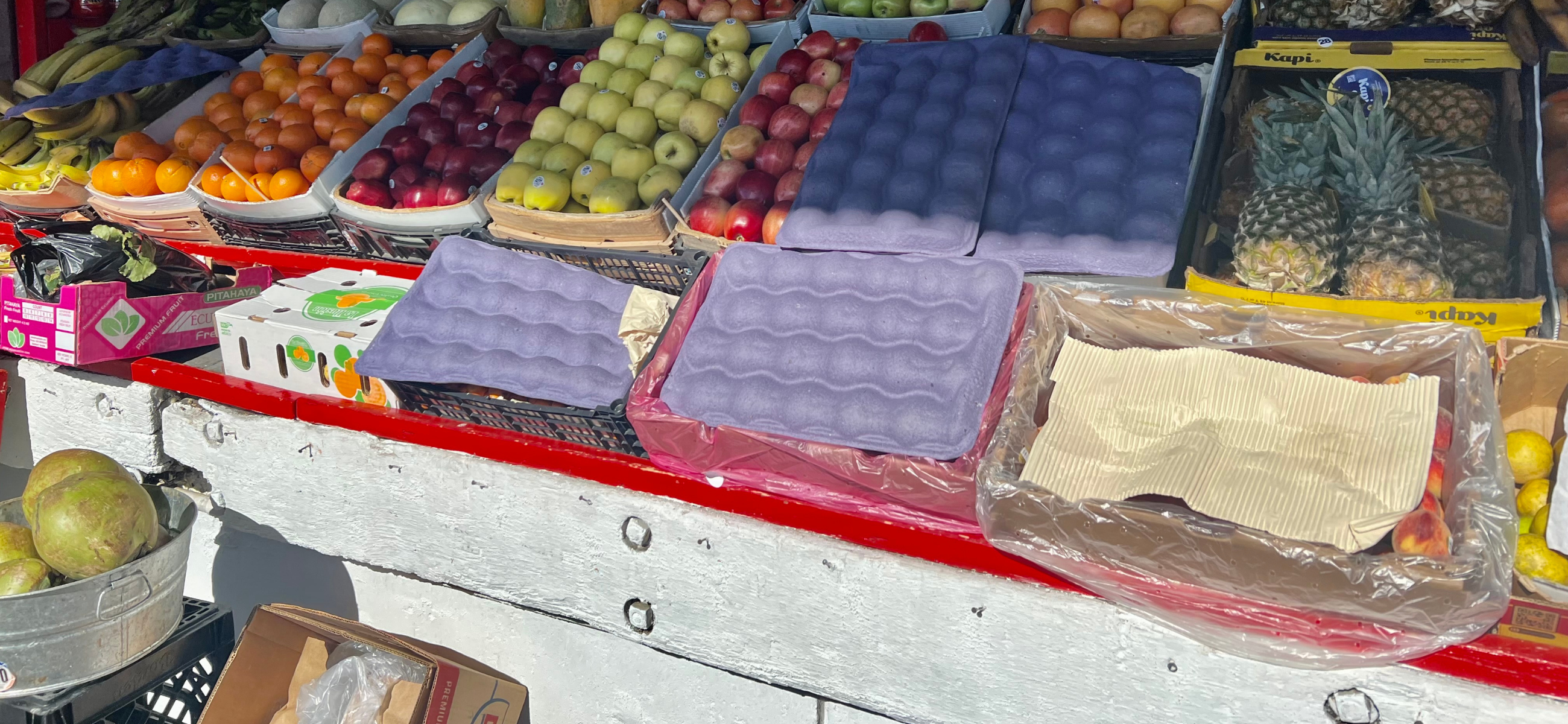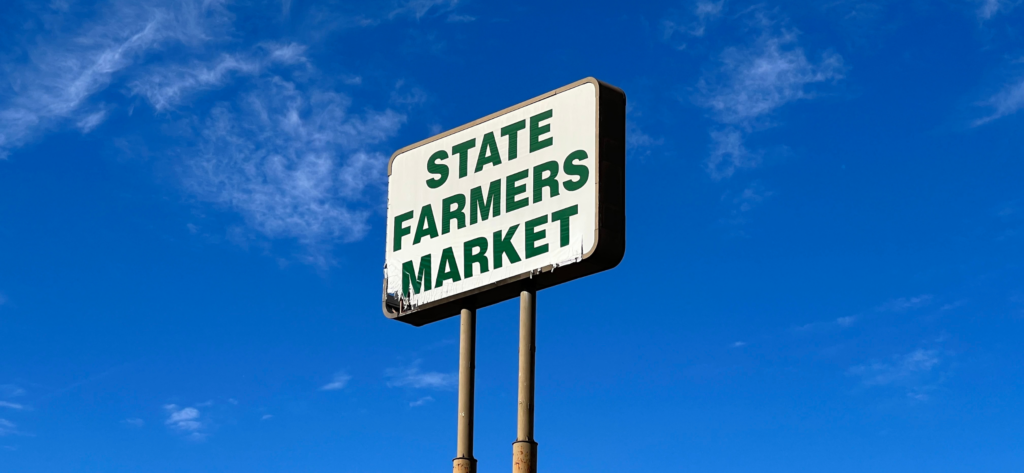Stay ahead of the curve as a political insider with deep policy analysis, daily briefings and policy-shaping tools.
Request a DemoAtlanta State Farmer’s Market may get $50 million face-lift under Kemp’s proposed budget

Peeling paint and rotting wood are some of the signs of needed repairs at the Atlanta State Farmer's Market. (Credit: Tammy Joyner)
At 66 years old, the Atlanta State Farmer’s Market is in need of a major face-lift.
Its marquee hovering over I-75 is the first visible indication that what has been described as the “world’s largest fruit and vegetable stand” is in disrepair.
“The framework around [the sign] is coming loose. And that sign is flapping back and forth,” Robert McQueen said, pointing up to the sign. “And every time we get a head of wind, man, that thing is dangerous.”

McQueen has worked at the market since 1980. He sells plants and other nursery products at Shed 31, a wooden enclosure directly under the market sign.
“They fixed it once about 15 years ago, but it’s fallen apart,” he said. “ I’ve been in touch with the maintenance department. But it’s always about money.”
Money might not be an issue much longer.
The market — one of the largest in the Southeast if not the nation — is slated to get a $50 million makeover. It’s a line item in Gov. Brian Kemp’s proposed Capital Projects Fund Grant Program set forth in his amended fiscal year 2024 budget. It is the first major renovation of the 150-acre complex since it opened in Forest Park on Jan. 19, 1958, state agriculture officials said.
McQueen welcomed the news: “They need it to do repairs.”
Many of the buildings, sheds and open-air shelters where food is displayed need painting, repairing or replacing. The facilities at the complex have about 1.5 million square feet of space, according to the state agriculture department. Most of them were built in the 1950s and 1960s and haven’t had significant updates since they were built, state agriculture officials said.
The Forest Park complex is part of a network of nine state farmers markets providing fresh produce and other foods throughout Georgia and the Southeast. These markets bring in over $1 billion in sales yearly.
“The Atlanta State Farmer’s Market is in need of significant capital investment, and we’re grateful Gov. Kemp and the General Assembly recognize that need,” Agriculture Commissioner Tyler Harper told State Affairs. “These much-needed funds will allow us to address a decadeslong backlog of deferred maintenance while also making large-scale improvements to many of our aging facilities, safety and security upgrades, and updating critical infrastructure so vendors and customers can have a positive experience.”
The market sits in Rep. Rhonda Burnough’s district. The Democrat who represents Riverdale said the facility needs across-the-board repairs given the trucks and traffic that continually pass through the complex.
The money is “going to be a windfall for them to be able to do some much-needed work so they can continue to be the largest,” she said.
The complex, which operates round-the-clock, 365 days a year, has supplied the South with everything from apples to zucchini for six decades. It has over 90 businesses, including large wholesale produce operations that sell to grocery stores, restaurants and other produce dealers. The smaller businesses typically operate out of the sheds and stalls, selling products directly to consumers.

What’s not grown locally or in the state comes from Mexico, Canada, Argentina, Chile, Venezuela and other countries in the off-season. The market supplies not only grocery stores and restaurants but also schools and prisons, as well as visitors like Veronica Davis of Conyers.
“It’s more affordable here, and there’s so much to choose from,” Davis told State Affairs. She came to the market to get “vegetables for juicing.” Davis purchased radishes, beets, six zucchini, an apple and three fresh coconuts, one of which was promptly opened by the vendor so she could sip the water. She paid about $10 for the produce.
“That’s great,” Davis said when she learned the market would get a $50 million infusion for renovations. “You look around and you can tell it’s definitely needed. The farmers will definitely like that.” While she spoke, 18-wheelers drove through the complex where open-air shelters brimmed with seasonal vegetables.
The renovations have been a long time coming. State House representatives created a study committee in 2017 to determine ways to revamp the aging complex.
At that time, “We were able to get some money in the budget to do some of the repairs but not all of them,” said former Rep. Valencia Stovall, who chaired the committee. “When we had the study committee, we were looking at how to make it even more efficient, getting the products moved through the trucks and the roadway. So just to hear that Gov. Kemp and the legislature are looking at designating that much-needed money, and because agriculture is our No. 1 commodity in the state, I think it’s great. A lot more can be done over there.”
State Rep. Sandra Scott, D-Rex, said the proposed money “is a great start.”
“It’s been a long time coming,” Scott told State Affairs. “The farmers market has a lot of land out there. It would bring a lot of business to Clayton County, Forest Park and that area because people come from all over for the farmers market. It would be a big support if they could get some eateries where people can go and sit down and eat while they’re shopping. I’m just hoping they have a master plan.”
The timing is right as more people look for ways to eat healthier without spending a lot of money, Scott said.
“I’m really big on growing and eating your own,” she added. “You hear more and more people talk about fresh food and farm-to-table, and a lot of people are getting into gardening. All of this is good.”
TIMELINE: A LOOK AT THE ATLANTA STATE FARMER’S MARKET
The Atlanta State Farmer’s Market had several homes before moving to Forest Park in 1958. Here’s an evolutionary look at the market.
1936: An Atlanta farmers market opens at Courtland and Gilmer streets on the old Boys’ High School site in downtown Atlanta. The land lease at this location ended at midnight Dec. 31, 1940.
1938: The Georgia Department of Agriculture wants to open a new market on a 16-acre tract at Murphy Avenue and Sylvan Road, noting the current downtown facility was “filled to overflowing.” State agriculture officials seek a centrally located market in Atlanta to take care of other state markets and overflows.
May 10, 1941: The market, also known as the Atlanta Farm Market, moves to Murphy Avenue near Sylvan Road in Southwest Atlanta where it stays for 18 years. The new market has six produce buildings, an administrative building and three steel sheds. It costs $340,000 to build.
1946: The Murphy Avenue market needs more space. Ag Commissioner Tom Linder said his department needs $5 million to add more buildings and provide more space where big trucks can park to display their goods. Fruits and vegetables come from as far as Mexico and Canada in the off-season to be sold at the market, and 80% of the produce is trucked out of state.
1947: Ongoing overcrowding requires more police to direct traffic during the summer and a line of trucks waiting for parking.
1956: The state buys a 140-acre site along I-75 in Clayton County.
Jan. 19, 1958: The Atlanta Farmer’s Market opens in Forest Park, marking the close of the Murphy Avenue market.
2017: State House representatives create a study committee to determine ways to revamp the aging complex.
January 2024: The 150-acre Forest Park facility is slated for a $50 million face-lift under Gov. Brian Kemp’s budget proposals. One of the largest of its kind in the United States, the outdoor market features a garden center and wholesale and retail activities. It’s also a major marketing hub and distribution point for fresh produce in the Southeast and the nation. The facility is open 24 hours a day, 365 days a year, and provides food from around the state and world. It’s in need of repairs, painting and other structural updates.
Sources: Georgia Department of Agriculture, exploregeorgia.org, Wikipedia and staff research.
Have questions? Contact Tammy Joyner on X @lvjoyner or at [email protected].
And subscribe to State Affairs so you do not miss an update.
X @StateAffairsGA
Facebook @StateAffairsGA
Instagram @StateAffairsGA
LinkedIn @StateAffairs
Professionals still face licensing delays amid state’s transition to online system
The Gist Georgia’s professionals and business owners are still struggling to obtain professional licenses in a timely manner. As the Secretary of State’s Office rolls out its new Georgia Online Application Licensing System to expedite the process, the efficiency of this new process is being put to the test. What’s Happening Thursday morning at the …
Controversy over AP African American Studies class grows
Rashad Brown has been teaching Advanced Placement African American Studies at Atlanta’s Maynard Jackson High School for three years. He’ll continue to do so — even though the state’s top education official removed it from the list of state-funded course offerings for the upcoming school year. While Brown prepares to start teaching his class on …
Students, teachers, lawmakers blast decision to end AP African American history classes
ATLANTA — A coalition of lawmakers, civil rights leaders, clergy, educators and students Wednesday called on the state’s education czar to rescind his decision to drop an advanced placement African American studies class from the state’s curriculum for the upcoming school year. “This decision is the latest attack in a long-running GOP assault on Georgia’s …
Kamala Harris’ presidential bid reinvigorates Georgia Democrats
Georgia Democrats have gained new momentum heading into the November election, propelled by President Joe Biden’s decision to bow out of his reelection bid and hand the reins to Vice President Kamala Harris. The historic decision, announced Sunday, is expected to prove pivotal in the national and state political arenas and breathe new life and …




